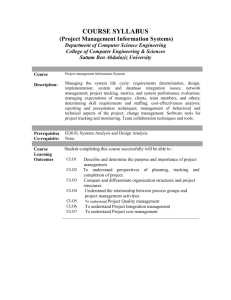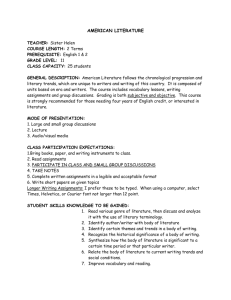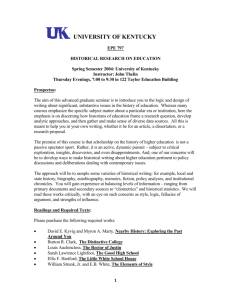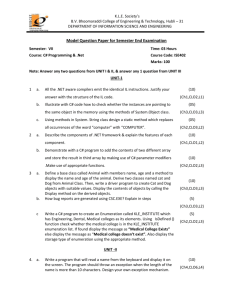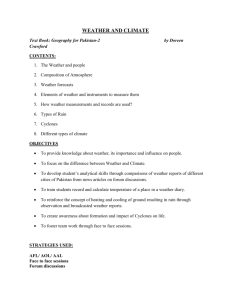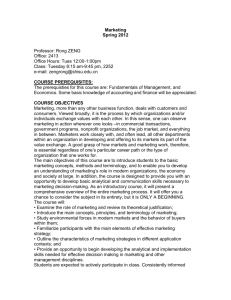Course Description
advertisement
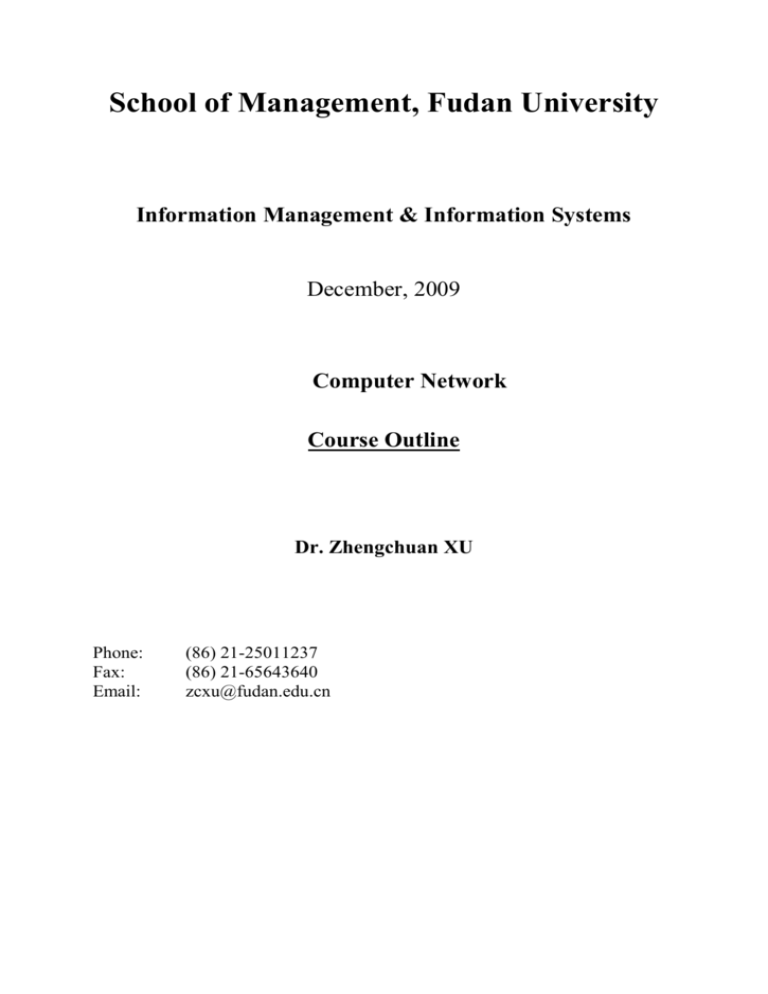
School of Management, Fudan University Information Management & Information Systems December, 2009 Computer Network Course Outline Dr. Zhengchuan XU Phone: Fax: Email: (86) 21-25011237 (86) 21-65643640 zcxu@fudan.edu.cn Computer Network I. Course Information Course Description: Business telecommunications is one of the fastest growing areas in industry today. The use of local- and widearea networks has become common place. Data communications technology provides the necessary infrastructure for client-server architecture, the internet, intranets and extranets, groupware, and any e-business application. This course introduces students to both managerial issues as well as the supporting technical knowledge needed to plan and manage today’s business communication system. The course begins with an introduction to the data communications concepts and technologies, followed by a technical review of the network services, including LANs and WANs, the Internet and internetworking, and enterprise networks. We then turn to look at some issues relating to network security and management. Course Objectives: Describe the basic principles of Computer Networks. Distinguish between basic communication concepts and terminology. Grasp the concepts in the connectivity of stand alone LANs and WANs Intelligently converse with others on the subjects of various network architecture and topology. Describe employ the Open Systems Interconnect(OSI) and TCP/IP model and use this model to explain typical data communications Internet, Extranet and Intranet architectures Use the technical vocabulary of data communication technology to design, implement and manage organizational communications functions Understand the role of data communications as an integrator of business processes. explain selected technical issues underlying the integration of business processes Create an oral and/ or written presentations about a current data communications topic. Course Materials: Textbook: Business Data Networks and Telecommunications, Raymond R. Panko. 6th edition (2007) Cases & Articles: 1. 2. 3. 4. 5. 6. Choi, Y.B., etc (2006) ‘Corporate wireless LAN security: threats and an effective security assessment framework for wireless information assurance’, Int. J. Mobile Communications, Vol. 4, No. 3, pp.266–290. Kumar, S. (2004) ‘Mobile communications: global trends in the 21st century’, Int. J. Mobile Communication, Vol. 2, No. 1, pp.67–86. Varshney, U., Malloy, A., Ahluwalia, P. and Jain, R. (2004) ‘Wireless in the enterprise: requirements, solutions and research directions’, Int. J. Mobile Communications, Vol. 2, No. 4, pp. 354–367. Lim, B. and Zheng, H. (2004) ‘A day in the life of Jini: a peek at service-oriented architecture for internet appliances’, Int. J. Mobile Communication, Vol. 2, No. 2, pp.199–216. Pietro, R.D. and Mancini, L.V. (2003) Security and privacy issues of handheld and wearable wireless devices, Communications of the ACM, Vol 46, No. 9. Wei, J., Liu, L.C. and Koong, K.S. (2006) ‘An onion ring framework for developing and assessing mobile commerce security’, Int. J. Mobile Communications, Vol. 4, No. 2, pp.128– 142.. 2 Computer Network References: Business Data Communications and Networking, Fitzgerald, J., Dennis, A. John Wiley & Sons, Inc., New York, NY, 7th Edition, (2002). Local Area Networks, Forouzan, B. A. McGraw-Hill, New York, NY, 1st Edition, (2002). Business Data Communications Stallings, W. Prentice Hall, Upper Saddle River, New Jersey, 4th Edition, 2001. Nerds 2.0.1: A Brief History of the Internet. Segaller, Stephen. New York: TV Books [ISBN: 1-57500-088-1] (1999). 3 Computer Network II. Course Learning Outcomes (CLOs): On completion of this course, students should be able to: Develop knowledge of principles, concepts, and technology in the data communication to conceptualize a network and specify its components. (CLO1) Develop the ability to analyze the business needs of an organization and apply the correct networking solutions. (CLO2) Develop the ability to design and document a large network, convey that design to managers in an understandable way and the ability to work network engineers and technicians to ensure the successful implementation and on going maintenance of a network. (CLO3) Develop capabilities for case study and analysis of contemporary data communication and network management. (CLO4) Alignments of Program and Course Learning Outcomes: Undergraduate Students Learning Outcomes 1. Solid theoretical basis, strong professional skills, and logical modes of thinking. Course LOs CLO1, CLO2, CLO3 2. Collection and measurement of data and information CLO1, CLO2, CLO4 3. Written and Verbal Communication Skills CLO1, CLO3, CLO4 4. Research Skill in Problem Solution CLO2, CLO3, CLO4 5. A strong sense of social responsibility and high ethical standards CLO4 Teaching and Learning Activities: Lectures: basic concepts and knowledge will be presented in the class through. In-class discussions: sometimes discussion questions are raised by the lecturer. Students are encouraged to participate in discussions and share opinions with their peers. These discussions encourage students to think more for certain arguable topics. Assignments: students accomplish tasks using technologies covered in class. Through the assignments they can acquire hands-on experience using these technologies. Group project: students forming groups to practice the research study, project initiation/selection, planning, execution, summarization, presentation and evaluation. Small group meeting & discussion: multiple discussion sessions with individual small group during the semester to provide the feedback and suggestions for course project and case study. Case study: students express and share their ideas and questions on the case or articles related to network in the class. These discussions encourage students to think about the class materials after class. Demonstration: live demonstrations of software and technologies used in the network (such as video conferencing, schedule management, and optimization tools) will be given in the class and lab session to show how these technology applied in the network. Videos: video clips are shown for selected topics in the class to show the real scenarios in the different situations for network. Students are required to answer questions and problems based on the video contents. These questions offer students opportunities to apply basic concepts and techniques to specific scenarios. 4 Computer Network Measurement of Learning Outcomes: Learning outcome Develop knowledge of principles, concepts, and technology in the data communication to conceptualize a network and specify its components. (CLO1) Develop the ability to analyze the business needs of an organization and apply the correct networking solutions. (CLO2) Develop the ability to design and document a large network, convey that design to managers in an understandable way and the ability to work network engineers and technicians to ensure the ensure the successful implementation and on going maintenance of a network. (CLO3) Develop capabilities for case study and analysis of contemporary data communication and network management. (CLO4) Teaching and learning activity Lectures, in-class discussions, assignments, group project, case study, tutorials Assessment Attendance, participation in discussions, assignments, case study. Lectures, in-class discussions, assignments, group project, group meeting, case study, tutorials Attendance, participation in discussions, assignments, case study, project presentation and summary report. Lectures, in-class discussions, assignments, exams, group project, group meeting, case study, Attendance, participation in discussions, case study, project presentation and summary report. Lectures, In-class discussions, assignments, group meeting, case study, Attendance, participation in discussions, case study, project presentation and summary report. 5 Computer Network III. Process for Assessment In-class participation (30%) Participation in class discussion, group discussion, presentation and playing a proactive role in other inclass activities. Group Case Study - Each group will be assigned one case in the beginning of the course and need to submit the case presentation (i.e. power point file) before the lecture of presentation/discussion. Individual written assignment (30%) Softcopy to teaching assistant and lecturer Including question /answer, summary of reading, and research. * Electronic submission preferable (No late submission) Group project (40% = 20% Report + 20% Presentation) Project topics will be either assigned by lecturer or proposed by project members (with lecturer’s approval). 20-minute presentation followed by 10 minute Q&A (April 12, 2008) Submission of Written report + presentation file (due date: April 27, 2008) IV. Course Policies Academic Dishonesty: The University Regulations on academic dishonesty will be strictly enforced. Academic dishonesty is behavior in which a deliberately fraudulent misrepresentation is employed in an attempt to gain undeserved intellectual credit, either for oneself or for another. It includes, but is not necessarily limited to, the following types of cases: a. Plagiarism - The representation of someone else’s ideas as if they are one’s own. Where the arguments, data, designs, etc., of someone else are being used in a paper, report, oral presentation, or similar academic project, this fact must be made explicitly clear by citing the appropriate references. The references must fully indicate the extent to which any parts of the project are not one’s own work. Paraphrasing of someone else’s ideas is still using someone else's ideas, and must be acknowledged. b. Unauthorized Collaboration on Out-of-Class Projects - The representation of work as solely one's own when in fact it is the result of a joint effort. c. Cheating on In-Class Exams - The covert gathering of information from other students, the use of unauthorized notes, unauthorized aids, etc. d. Unauthorized Advance Access to an Exam - The representation of materials prepared at leisure, as a result of unauthorized advance access (however obtained), as if it were prepared under the rigors of the exam setting. This misrepresentation is dishonest in itself even if there are not compounding factors, such as unauthorized uses of books or notes. 6 Computer Network V. Course Schedule Lecture Subject Supplement/Reference Chapter One; 2/23 Course overview Core Network Concepts Standard 3 3/2 Physical Layer Propagation Chapter Three; 4 3/9 Lab on physical layer 5 6 7 3/16 3/23 3/30 Hand-On: cutting and connetorizing UTP Chapter Four; 8 4/6 9 4/13 10 4/20 11 4/27 WANs 12 5/4 Case Study 13 5/11 TCP/IP Internetworking 14 5/18 Lab on TCP/IP 15 5/25 Security 16 6/1 Security Lab & Case Study 17 6/8 Network Management 18 6/15 Project Presentation 19 6/22 Examination 1 2/16 2 Ethernet LANs Lab on creating LAN Wireless LAN Presentation On Lastest wireless technology and mobile commerce Telecommunication Presentation On Lastest WAN technology Homework Chapter Two; Case report Chapter Five; Presentation Chapter Six; Presentation Chapter Seven; First Bank of Paradise’s wide area networks Chapter Eight; Hands-On: Packet Capture and Analysis with WinDUMP and TCPDUMP Chapter Nine; Hands-On: Windows Security Case Report Case Report Case Report Chapter Ten; Project Report Due 7

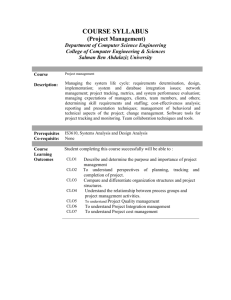
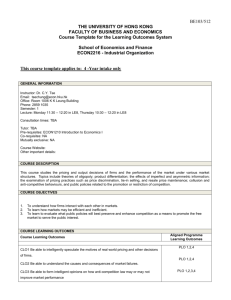
![Syllabus [Word]](http://s3.studylib.net/store/data/006967311_1-8dc868a12812e520f131dbbe02cc269a-300x300.png)
